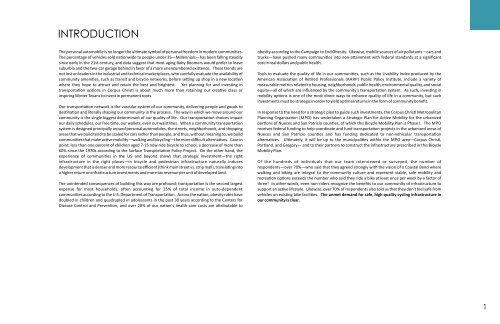Phase 1 Bike Plan_r
You also want an ePaper? Increase the reach of your titles
YUMPU automatically turns print PDFs into web optimized ePapers that Google loves.
INTRODUCTION<br />
The personal automobile is no longer the ul mate symbol of personal freedom in modern communi es.<br />
The percentage of vehicles sold na onwide to people under 35—Millennials—has been falling steadily<br />
since early in the 21st century, and data suggest that most aging Baby Boomers would prefer to leave<br />
suburbia and the two-car garage behind in favor of a more unencumbered existence. These trends are<br />
not lost on leaders in the industrial and technical marketplaces, who carefully evaluate the availability of<br />
community ameni es, such as transit and bicycle networks, before se ng up shop in a new loca on<br />
where they hope to a ract and retain the best and brightest. Yet planning for and inves ng in<br />
transporta on op ons in Corpus Chris is about much more than retaining our crea ve class or<br />
inspiring Winter Texans to invest in permanent roots.<br />
Our transporta on network is the vascular system of our community, delivering people and goods to<br />
des na on and literally shaping our community in the process. The way in which we move around our<br />
community is the single biggest determinant of our quality of life. Our transporta on choices impact<br />
our daily schedules, our free me, our wallets, even our waistlines. When a community transporta on<br />
system is designed principally around personal automobiles, the streets, neighborhoods, and shopping<br />
areas that we build tend to be scaled for cars rather than people, and thus, without meaning to, we build<br />
communi es that make ac ve mobility—walking and bicycling—the more difficult alterna ves. Case in<br />
point: less than one percent of children aged 7-15 now ride bicycle to school, a decrease of more than<br />
60% since the 1970s according to the Surface Transporta on Policy Project. On the other hand, the<br />
experience of communi es in the US and beyond shows that strategic investment—the right<br />
infrastructure in the right places—in bicycle and pedestrian infrastructure naturally induces<br />
development that is denser and more resource efficient (think main street vs. strip mall), transla ng into<br />
a higher return on infrastructure investments and more tax revenue per unit of developed land.<br />
The unintended consequences of building this way are profound: transporta on is the second largest<br />
expense for most households, o en accoun ng for 25% of total income in auto-dependent<br />
communi es according to the U.S. Department of Transporta on. Across the na on, obesity rates have<br />
doubled in children and quadrupled in adolescents in the past 30 years according to the Centers for<br />
Disease Control and Preven on, and over 20% of our na on's health care costs are a ributable to<br />
obesity according to the Campaign to End Obesity. Likewise, mobile sources of air pollutants—cars and<br />
trucks—have pushed many communi es into non-a ainment with federal standards at a significant<br />
cost in real dollars and public health.<br />
Tools to evaluate the quality of life in our communi es, such as the Livability Index produced by the<br />
American Associa on of Re red Professionals (AARP) Public Policy Ins tute, include a variety of<br />
measurable metrics related to housing, neighborhoods, public health, environmental quality, and social<br />
equity—all of which are influenced by the community's transporta on system. As such, inves ng in<br />
mobility op ons is one of the most direct ways to enhance quality of life in a community, but such<br />
investments must be strategic in order to yield op mal returns in the form of community benefit.<br />
In response to the need for a strategic plan to guide such investments, the Corpus Chris Metropolitan<br />
<strong>Plan</strong>ning Organiza on (MPO) has undertaken a Strategic <strong>Plan</strong> for Ac ve Mobility for the urbanized<br />
por ons of Nueces and San Patricio coun es, of which this Bicycle Mobility <strong>Plan</strong> is <strong>Phase</strong> I. The MPO<br />
receives federal funding to help coordinate and fund transporta on projects in the urbanized areas of<br />
Nueces and San Patricio coun es and has funding dedicated to non-vehicular transporta on<br />
alterna ves. Ul mately, it will be up to the municipali es within the MPO area—Corpus Chris ,<br />
Portland, and Gregory— and to their partners to construct the infrastructure prescribed in this Bicycle<br />
Mobility <strong>Plan</strong>.<br />
Of the hundreds of individuals that our team interviewed or surveyed, the number of<br />
respondents—over 70%—who said that they agreed strongly with the vision of a Coastal Bend where<br />
walking and biking are integral to the community culture and represent viable, safe mobility and<br />
recrea on op ons exceeds the number who said they ride a bike at least once per week by a factor of<br />
three! In other words, even non-riders recognize the benefits to our community of infrastructure to<br />
support an ac ve lifestyle. Likewise, over 70% of respondents also told us that they don't feel safe from<br />
vehicles on exis ng bike facili es. The unmet demand for safe, high quality cycling infrastructure in<br />
our community is clear.<br />
1


